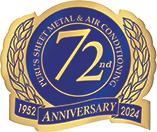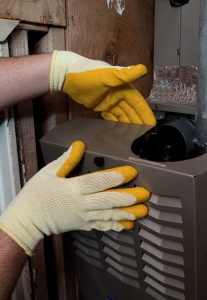Gas furnaces are reliable and powerful heating systems that can work for many years delivering warmth to a home. It’s why they’re still the most common household heating system across the country.
Some homeowners are cautious about using gas furnaces because of possible safety hazards. Burning natural gas in any appliance has some risk of uncontrolled combustion and toxic gas leaks. But as long as a furnace receives regular maintenance each year and prompt repairs when needed, the risk is minimal.
We want to focus on one specific furnace repair problem that can create serious health hazards: a cracked heat exchanger. The more you know about it, the easier it will be to prevent it.
The Job of the Heat Exchanger
The heat exchanger is the part of a gas furnace that does the actual heating of the air moving through the furnace and into the ductwork. The exchanger is a metal container where the hot combustion gas from the burners collects when a furnace is running. The combustion gas raises the temperature of the walls of the heat exchanger, and then when the blower turns on, the air it pushes around the heat exchanger picks up heat from the walls.
The reason for having a heat exchanger in the first place is that the combustion gas cannot directly heat the air entering the house without allowing dangerous fumes to get into it. The exchanger serves as the “middleman” in the heating process.
Cracks in the Exchanger
Since a heat exchanger keeps harmful gases from entering the air, a crack is a potentially dangerous problem. A crack on the exchanger’s metal may not look like much, but when the exchanger heats up, the metal expands and causes cracks to open—enough to let toxic combustion gas byproducts seep into the air. This can mean carbon monoxide getting blown directly into the living spaces—and that’s bad!
There are several potential causes of heat exchanger cracks. One is age: after years of the metal of the exchanger expanding and contracting, the stress can lead to cracks. Another cause is, which can form along the heat exchanger because of poor venting of gases from the exchanger. Corrosion weakens metal, making it easy for cracks to start.
What You Can Do About Heat Exchanger Cracks
The best tool to use against this problem is prevention—always schedule your furnace for maintenance each year, preferably in the fall. Our technicians will catch any problem that may lead to cracks so we can apply the proper furnace repair in Fresno, CA to correct it. We will also detect when cracks have formed and take the proper steps to fix it. For older furnaces, we strongly recommend replacing the unit when cracks start to occur.
Your key protection inside your home against the dangers of heat exchanger cracks is CO detectors. Make sure to check all your home’s detectors before winter to ensure they’re working. They’ll provide you with the necessary warning of increasing CO levels in your home so you can vacate and call the gas company.


